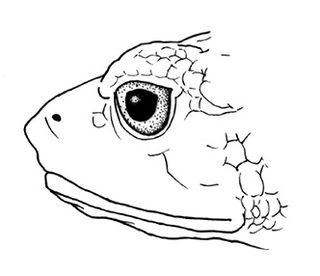
Atelopus is a large genus of true toads, commonly known as harlequin toads or stubfoot toads, from Central and South America, ranging as far north as Costa Rica and as far south as Bolivia. Atelopus species are small, generally brightly colored, and diurnal. Most species are associated with mid-to-high elevation streams. This genus has been greatly affected by amphibian declines, and many species are now considered endangered, while others already are extinct. Almost 40% of the described species in the genus are considered possibly extinct; this is raised to 45% when data deficient species are added; this number may be even higher, given that the genus contains many undescribed species that could also be extinct, and many of the species considered critically endangered but extant may have gone extinct after the last surveys that detected them, or could go extinct in the future. While threatened by habitat loss, pollution, and introduced species, the primary cause of these declines appears to be the chytrid fungus Batrachochytrium dendrobatidis. For example, there are 32 known Atelopus species in Ecuador. One of these is data deficient, two are endangered and the remaining are critically endangered. Almost half the Ecuador species have not been recorded in a decade or more and are likely extinct. In some species conservationists have established captive colonies as a safeguard. However, numerous Atelopus species have been rediscovered decades after their last sighting, such as A. arsyescue, A. mindoensis, A. bomolochos, A. ignescens, A. balios, A. longirostris, A. subornatus and A. varius.

Osornophryne is a genus of true toads endemic to the Cordillera Central in Colombia and central Andes in Ecuador.

The Carchi Andes toad, Rhaebo colomai, is a species of toad endemic to the western slopes of the Andes in northern Ecuador and southern Colombia. It is listed as an endangered species due to a restricted range and habitat loss.

Atelopus longirostris is a species of harlequin frog, a member of the family of true toads (Bufonidae). It has been recorded only in northern Ecuador. Records from Colombia probably represent different species. As of mid-2017, it is listed as extinct by the IUCN, but was rediscovered in 2016 after more than two decade with no sightings. The scientific name of this species means "long-snout" and the species has been named in Spanish as the jambato hocicudo. Common names longnose stubfoot toad, scrawny stubfoot-toad, and longnose sharlequin frog have been coined for it.
Rhaebo olallai is a species of toad in the family Bufonidae endemic to Ecuador. Its common name is Tandayapa Andes toad, after its type locality, Tandayapa, in the Pichincha Province); the species has not been seen there after 1970, despite search efforts. It is only known from another locality in the Imbabura Province of Ecuador. It has also been reported from one locality on the Colombian Massif, Nariño Department, Colombia, but these have been shown to represent Rhaebo colomai.

Atelopus balios, the Rio Pescado stubfoot toad, is a species of toad in the family Bufonidae. It is endemic to southwestern Ecuador, with records from Pacific lowlands in Azuay, Cañar, and Guayas Provinces. It is a rare species that was already suspected to be extinct, but a single specimen was discovered in 2011 by a team from Conservation International during a hunt for missing amphibians. The decline in amphibian populations is well documented. The Atelopus balios is Critically Endangered as a result of the widespread amphibian Chytridiomycosis fungus that has decimated other amphibian populations. There are only 10 known findings of the tadpole, Atelopus balios.

Atelopus exiguus is a species of toad in the family Bufonidae. It is endemic to Ecuador and only known from the area of its type locality in the Azuay Province of southern Ecuador, in the sub-páramo and páramo of Cordillera Occidental. Common name Mazán jambato frog has been proposed for it.

Atelopus ignescens, the Jambato toad or Quito stubfoot toad, is a species of toad in the family Bufonidae. It is endemic to the northern Andes of Ecuador. This once abundant species was believed to be extinct until its rediscovery in 2016. The specific name ignescens means "to catch fire", presumably in reference to the orange ventral color of this species.
Atelopus pachydermus is a species of toad in the family Bufonidae. It is found in the Andes of northern Peru and southern Ecuador. Records from Colombia reflect the vagueness of the stated type locality, "Neu-Granada", encompassing territory part of several present-day countries. Other records outside the current range refer to other species. The most recent record of this very rare and possibly extinct species is from around 1995. However, there is a need to reassess the status of this species because of confusion with Atelopus podocarpus.
Atelopus planispina is a species of toad in the family Bufonidae. It is endemic to the eastern slopes of the Andes of Ecuador. According to the IUCN SSC Amphibian Specialist Group, it is restricted to the Napo Province, although other sources suggest somewhat wider range. It has not been seen since 1985 and might already be extinct. Common names Planispina's harlequin frog, Napo stubfoot toad, and flat-spined atelopus have been coined for it.
Rhinella amabilis is a species of toads in the family Bufonidae that is endemic to Ecuador, only occurring in a severely fragmented area less than 100 square kilometres (39 sq mi).

The South American common toad is a species complex of toads in the family Bufonidae. They are found throughout the Amazonian South America and eastern Panama. It was originally believed to be a single species, but is now known to represent a complex of more than one.

Osornophryne antisana, the Napo plump toad, is a species of toad in the family Bufonidae. It is endemic to Ecuador. Its natural habitats are subtropical or tropical moist montane forests, subtropical or tropical high-altitude shrubland, and subtropical or tropical high-altitude grassland. It is threatened by habitat loss.

Osornophryne bufoniformis is a species of toad in the family Bufonidae. It is found in the Andes of southern Colombia and northern Ecuador. Common name Peracca's plump toad has been proposed for it, in allusion to Mario Giacinto Peracca, the scientist who described this species in 1904.

The Guacamayo plump toad or sapo de Guacamayo is a species of toad in the family Bufonidae occurring in Colombia and Ecuador.

The Herveo plump toad is a species of toad in the family Bufonidae. It is endemic to the Cordillera Central in the Antioquia, Caldas, Quindío, and Tolima Departments, Colombia.

Osornophryne sumacoensis is a species of toad in the family Bufonidae. It is endemic to the Ecuador and only found in the forests surrounding a small crater lake on the eastern slopes of Sumaco, a volcano in the Napo Province.

The Cannatella's plump toad is a species of toad in the family Bufonidae. It is found in Colombia and Ecuador. Its natural habitats are subtropical or tropical moist montane forests and subtropical or tropical high-altitude shrubland. It is threatened by habitat loss.

Sumaco Napo-Galeras National Park is a protected area in Ecuador situated in the Napo Province, Orellana Province and Sucumbíos Province. The highest point of the park is the Sumaco volcano that peaks at 3,732 m; the lowest altitude is 600 m.

Sumaco is a symmetrical, isolated stratovolcano, that is set off from the main Ecuador volcanic axis. Its rocks are very distinct from those from most Andean volcanoes because of its lack of andesitic composition, in favour of basanite and phonolitic rock. Sumaco is heavily forested and contains a small cone in its broad summit crater. An historical eruption occurred around 1895.
















